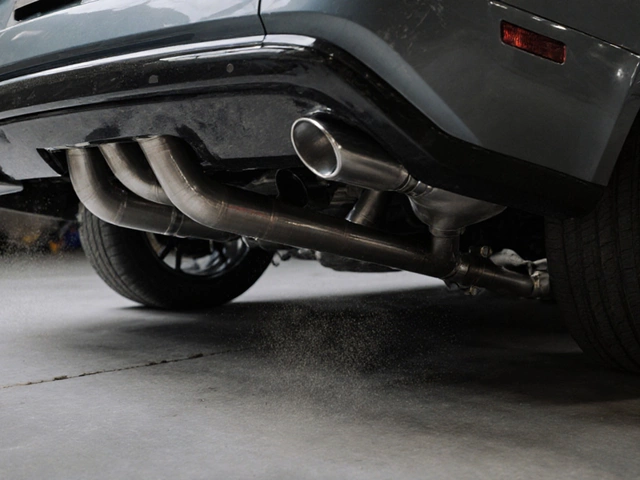Think a bigger exhaust is only for race cars or tuners flaunting their latest mods? The debate over that extra inch in your car’s exhaust system stirs up more opinions than almost anything else under the hood. Some folks swear swapping to a 3-inch exhaust wakes up hidden ponies and unleashes a beastly growl. Others claim it's just a noisy way to drain your wallet for almost zero real gains. What's really going on when you upsize your exhaust?
Why Diameter Matters in an Exhaust System
Engineers didn't randomly pick tiny pipes for your car’s stock exhaust. Diameter has a direct effect on the way exhaust gases flow away from your engine. Imagine sipping a smoothie through a cocktail straw—now try a wide bubble tea straw. You get the idea. If your engine's making more hot air, you need a way to get it out faster and with less restriction. That’s why performance upgrades often start with the exhaust. Back in 2015, a study from SEMA showed cars with forced induction (think turbos and superchargers) had gains up to 8% in power after swapping to a 3-inch exhaust. That’s nothing to sneeze at, but it’s not magic for every car.
The science is all about pressure waves and scavenging. Too small, and gases back up—hurting power. Too big, and the exhaust might slow down, hurting low-end torque. Car makers often use smaller diameter pipes because it’s quieter and cheaper, not because it’s best for power. Throw in performance mods and suddenly, those skinny pipes become a real bottleneck.
When Does a 3-Inch Exhaust Make Sense?
A 3-inch exhaust isn’t a ticket to horsepower on its own. It really depends on your engine setup. If you’re running a naturally aspirated four-cylinder with modest power, going jumbo can sometimes hurt your driving experience. In fact, dyno tests from Honda Tuning magazine in 2017 showed stock Civics lost a bit of low-end power with oversized pipes. Big-bore exhausts help most when you’ve got a turbo spitting out more boost or a V8 breathing fire.
If your engine moves a lot of air (high horsepower turbo or supercharged motors, or big-displacement V8s), a 3-inch system can cut down exhaust backpressure and let the engine rev free. Tuners will often point to cars making over 300 horsepower as good candidates for a 3-inch pipe. Anything less, and you’re mostly adding noise and potentially losing some of that sweet bottom-end grunt you use in daily driving. But if you love that deep, throaty note a 3-inch system makes—it might be worth it for sound alone.

The Pros: Power, Sound, and Heat
The big wins with a 3-inch exhaust are in potential horsepower, torque at higher RPMs, and heat management. A larger pipe gives hot gases an easier route out, which can especially help when you’ve got a smaller, more restrictive stock exhaust choking things up. In turbo cars, lower backpressure means the turbo spools up quicker, shaving precious tenths off launch times. Street racers even do back-to-back quarter-mile runs and see modest but noticeable gains—sometimes dropping from a 14.2 to a 13.8-second ET just from exhaust upgrades.
But let’s talk heat, too. Aftermarket exhausts generally use less restrictive, often lighter materials. Steel and titanium options drop the weight hanging under your car, while also letting exhaust heat escape faster. This cuts heat soak around the engine bay, which matters if you’re running long sessions or stuck in traffic with a boosted motor that's building up steam. Also, a 3-inch system usually sounds deeper and more aggressive—the kind of growl that makes car meets turn heads. Here, check this out:
| Parameter | Stock Exhaust | 3-Inch Exhaust |
|---|---|---|
| Pipe Diameter | 2.25"-2.5" | 3.0" |
| Typical Power Gain | 0-3% | 2-8% |
| Weight | Heavier (mild steel) | Lighter options for aftermarket (SS, Ti) |
| Sound | Quieter | Louder, deeper |
| Backpressure | Higher | Lower |
One cool fact: drag racers have been using oversized exhausts since the 1970s to keep power up in cars pushing way past 500 horsepower. Fast-forward to today, and you’ll find turbo Subarus, Mustangs, and even Velosters running aftermarket 3-inch pipes, using less backpressure to get the most out of their tuning maps.
The Cons: Not Always What You Expect
Time for some cold water. If you’re rolling around in a daily commuter or mostly stock car, that giant exhaust might just be an expensive way to annoy your neighbors. Big pipes can cost you low-end torque, which is noticeable when pulling away from a stop or tackling hills. There’s also the sound: a 3-inch exhaust screams “performance,” but sometimes it’s a ticket magnet or just drones away on the freeway, making long drives less fun.
Then there’s installation. Not every car fits a huge aftermarket system easily—modifying hangers or cutting rear bumpers is sometimes in the cards. And smog checks? Some options aren’t street-legal in stricter states (think California’s CARB rules). Plus, if you skip the muffler and resonator to maximize flow, you could get everything from drone to outright rasp in the cabin. Try explaining to your partner why the car now drowns out their favorite playlist.
Fuel economy can also take a slight dip if you spend more time gunning it to hear that new, deep soundtrack. Most daily drivers won't see any benefit besides the noise, and on some family sedans or compacts, you could end up hurting resale value if potential buyers see it as a sign of rough treatment. So there’s a balance—sometimes more is just more, not better.

Tips for Choosing the Right Exhaust for Your Car
If you’re considering the leap to a 3-inch exhaust, start by asking what you want most—more power, better sound, improved looks, or a bit of everything. Check your current mods. Is your engine boosted, heavily tuned, or running power adders like nitrous? If not, maybe a smaller upgrade fits better.
- Always check if your car’s computer needs a tune after exhaust mods. Some cars will run rich or throw CEL codes after big hardware changes.
- Stainless steel systems cost more, but last longer and resist rust. Titanium is for folks who count grams, not dollars.
- If drone drives you nuts on road trips, pick a system with resonators or choose a brand known for “civilized” sound levels.
- Watch the diameter at connections—mixing 2.5- and 3-inch pipes creates bottlenecks that lose most of the benefits.
- If possible, check dyno charts from real-world users with similar builds. Honest numbers beat sales hype.
Got friends with upgraded exhausts? Good—ask them for a ride. The seat-of-the-pants feel is way more useful than any online sound clip. Some modern cars come with “active” systems—valves that change the exhaust path for stealth in the city or wild freeway runs. Aftermarket kits with similar setups can give you the best of both worlds: noise when you want, peace and quiet when you don’t.
One good rule: if your car makes under 250 horsepower and stays stock, a 2.5-inch system might be better suited for daily life. But if you chase bigger numbers, or you just love the bragging rights and sound, nothing says custom like a fat, polished tip and the roar of a 3-inch pipe.




